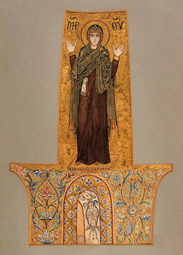Study of Mosaic: 'The Madonna and Rinceaux'
Eastern Dome, San Marco, Venice. Thomas Matthews Rooke (1842-1942). Watercolour and gold on paper, 1879.
WorkIn this work, Rooke copied the mosaic Madonna from San Marco's eastern dome. The dome is dominated by mosaic figures of prophets, patriarchs, Christ, as well as the Madonna. A window is situated directly below the figure, so that the gold mosaic catches the light.Ruskin commented particularly on the colours of this mosaic: 'The decorative power of the colour in these figures, chiefly blue, purple, and white, on gold, is entirely admirable, -- more especially the dark purple of the Virgin's robe, with lines of gold for its folds.' (Works, 24, p. 301). Rooke took careful note of Ruskin's comments on the mosaics and used gold paint to complete his mosaic studies.By 1879, Venice's authorities were restoring and replacing the Byzantine mosaics. Together with Edward Burne-Jones, Ruskin made a public plea, stating that 'every hour of my life, these mosaics become to me more precious, both for their art and their meaning'. He requested that the public help fund a project to record them in watercolour. The campaign was successful and this watercolour is one of a number painted by Rooke as part of the project.
Artist Rooke first worked in an army agent's office before attending evening classes in art and became a student at the Royal Academy in 1868. The following year he was employed by the designer William Morris's firm and became an assistant and close friend of the artist Edward Burne-Jones.Rooke enjoyed success as an artist in his own right. He painted large biblical scenes in a style influenced by Burne-Jones and Renaissance art, and exhibited at the Royal Academy. When Ruskin employed him, Rooke worked in a different style, drawing in watercolours and painting from life. Later, Rooke painted records of architecture for the Society for the Preservation of Pictorial Records of Ancient Works of Art. Collection of the Guild of St George, Museums Sheffield
Ruskin on MosaicRuskin considered ancient mosaic of the kind at San Marco 'the most important branch of early Christian art.' He saw the mosaics as an illustrated Bible, which 'could not be ignored or escaped from' (Works, 10, p. 132) by the worshipper. The style of these mosaics is described as 'Byzantine', a style that originated in Greece and Turkey during the late Roman times and culminated in the 1100s. Ruskin saw Byzantine art as an important stepping-stone from ancient classical art. Rejecting the conventional descriptions of the style as 'barbarous' or primitive, he presented it as a pioneering style, an influence on later art.In the course of his correspondence with Rooke, Ruskin wrote that 'The real fact is that all Byzantine mosaic (and all Eastern colour) has splendour for its first object -- and its type is the peacock's tail.'He adds, for Rooke's benefit, that 'If your drawings glow and melt like that you are right': 'Peacock's tail in shade or light it may be -- and much sober brown in any light may mix with its violet and gold -- but that is what the mosaicist wanted to do, and for the most part did'.Ruskin concludes, provocatively, that 'All that is grey, cold, reserved, or modest, in these mosaics (in any other sense than a humming-bird or flamingo or pheasant -- or aforesaid peacock -- is modest) is European, mostly Roman, some of it German -- all of it bad.' (Works, 30, p. lviii). |



















